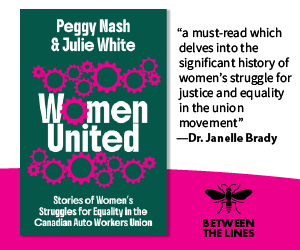Precarious Workers, Precarious Lives: Ontario’s Private Health Care Secret
In February 2011, a frail, 82-year-old Italian woman was threatened with charges of $1800 a day if she refused to move from Toronto’s Sunnybrook Hospital into the first available nursing home bed. Overcrowding in Ontario’s hospitals is a chronic problem that has forced the provincial government to evict people from hospital beds before they are healthy. These patients are then picked up by Community Care Access Centres (CCACs) across the province that act as gatekeepers to publicly available personal and medical support. The Province has pumped more than $700 million into their “Aging At Home” strategy, which paints the rosy picture of seniors aging independently in the comfort of their own homes with support and assistance.
Privatizing care
With Ontario’s senior population projected to double in the next 16 years, senior care is big business and numerous companies are cashing in at the expense of both workers and clients. Six large corporations now hold 76 percent of home care nursing contracts. In 1995 eight agencies held 66 percent of the contracts. Small community-based agencies have been virtually eliminated from the sector. US-based for-profit mega-health corporations like Extendicare–North America’s largest private senior-care provider–have set up shop across Canada and are now making profits upwards of $100 million a year.
In the mid-1990s Mike Harris’s Conservative government introduced contracting out and “competitive bidding” for home-care services. Today, CCACs provide care through private companies who compete for contracts to deliver care. The competitive bidding process is largely to blame for declining quality of care and driving down wages and benefits for those who work in the sector. And it has resulted in the terrain for sharing and spreading of innovation and best practices of care in the sector being nearly eliminated.
In 2007, competitive bidding eliminated two of the largest care providers in the Hamilton region. The VON & St. Joseph’s Home Care–non-profits with a combined 180 years of community service–provided about 80 percent of the home care in the region at the time. Workers, care recipients, unions and other working class allies quickly organized a town-hall meeting of over 1500 people to protest the loss. Escalating public pressure led the Liberal government to temporarily suspend the competitive bidding process a year later, and it remains suspended today. But little has changed. Contracts have been unilaterally extended by CCACs as they sit and wait for the nod from government to restart bidding. The pervasive insecurity for workers in the sector has not been eliminated. Employers have maintained pressure on workers both to increase profit margins and to maintain themselves in a constant state of preparedness for a resumption of a process that could occur at any moment. Prior to this suspension, the Ontario Health Coalition reported that competitive bidding is “rapidly ushering in an era of for-profit privatization in home care.” Indeed, competitive bidding has facilitated a dramatic expansion of the capacity of for-profit corporations to make huge profits from publicly funded health care.
Working in the home care sector
Many home-care workers care deeply about their clients and understand the social value of their work, but overwhelmingly these positive sentiments are tempered by the harsh reality of working in a sector that offers little or no job security and pitifully low wages. Workers provide both personal support services (showers, helping with household tasks) and medical support (administering medications and changing bandages) for seniors and people with disabilities. Minimum wage in the sector is $12.50 an hour, but experienced workers can earn up to 50 percent more per hour working in long-term care facilities and hospitals while enjoying better benefits, better working conditions, and greater job security.
The competitive bidding system essentially destroys job security for thousands of workers. Workers have no successor rights, meaning that when contracts between the CCAC and private-care providers expire, worker’s jobs are potentially on the chopping block. New agencies picking up contracts have no obligation to hire previous workers, and if they do workers can lose any benefits and seniority accrued with previous employers. This takes precarious employment to new levels, and has led to turnover rates as high as 60 percent in some areas of the province
Another consequence of competitive bidding has been to limit the number of minutes workers are able to spend with their clients in order to fit more visits in per day. This just-in-time logic has had a severe negative impact on those high need clients who may need showers, medical attention, and food prepared for them. Home-care workers and recipients consistently complain about the relentless reduction in the time they have to build relationships of trust and respect. Many workers report increases in unpaid overtime in efforts to meet their clients’ needs. Workers also face numerous safety hazards, including transporting machinery and equipment in their own vehicles, and working in isolation with clients who may physically and verbally abuse them. For many immigrant workers in this sector, neoliberal restructuring both in Canada and in their countries of origin has led to a deterioration of economic conditions, a decline in the real wage and a feminization of employment. In Ontario, home-care workers who have been in the sector for decades report that their jobs have become significantly worse under competitive bidding and that thousands are being driven out of the sector because they simply cannot make ends meet. Simultaneously, the erosion of welfare state protections has had a particularly harsh impact on care workers and their families.
Organizing the sector
Organizing workers in the home-care sector is notoriously difficult. Not only do large for-profit corporations have active union-avoidance strategies, but workers also have no fixed hours, work from no central location, and often do not know or even see their co-workers. Because of patient-confidentiality law, it is impossible to organize these workers in their workplaces: the homes of care recipients. The majority of organized home-care workers in Ontario are members of Service Employees International Union Local 1 Canada–a 46,000-member mega-local of health care and community workers. Historically, union density in the non-profits has been higher than in the for-profit corporations. Union membership in the sector has declined as non-profits have lost contracts.
SEIU has been expanding the strategy of business-style unionism where unions attempt to gain organizing rights with support, or at least non-interference, from corporations or the provincial government. This strategy has yet to deliver much for workers. There is no substitute for a serious and sustained commitment to organizing workers by involving them, and workers will be unable to win any major victories without a sustained campaign by unions and community partners to end the competitive bidding system.
Several unions in Ontario represent home care workers, and have taken clear positions against the competitive bidding process. Both CUPE and the Ontario Health Coalition have been arguing for many years that home care is an essential ingredient in the health-care system, and should be governed under the Canada Health Act. The idea has a generalized support but it raises a significant broader question: Under NAFTA is it possible to make public what once was private?
The global care crisis
On a world scale, access to care for those battered and bruised from decades of work is highly unequal. Patriarchy, racism and neoliberal restructuring have created an unholy alliance whereby the conditions by which care is received and provided are determined not by need but by class position.
This has created a cycle of precarious jobs leading to precarious and inadequate care. This cycle extends into the homes of those low-income women working in the sector who are unable to care for their own families, both in Canada and abroad. Feminist scholars have identified a crisis of “social reproduction” in the last few decades as households face reduced earnings and/or cuts to social spending on publicly provided care and pressure increases on women to “fill the gap.” Typically this work is unpaid, undervalued and performed by women. Even when care is provided outside the household–and provision of care through the market is growing–women generally continue to perform this undervalued work.
It is worth noting that the crisis of care has been created not only by global neoliberal restructuring but also persistent gendered divisions of labour. Numerous studies have shown that although women have entered the workforce in great numbers over the past few decades, men have done little to correspondingly increase their share of household labour.
As a result, as Barbara Ehrenreich and Arlie Russell Hochschild argue, “the presence of immigrant nannies,” and to this we could add other immigrant-care workers, “does not enable affluent women to enter the workforce; it enables affluent men to continue avoiding the second shift.” And critically, the state has not stepped in to pick up the slack.
The racialized and immigrant women providing care to Ontario’s expanding senior population know the importance of their work, yet they are subject to a system that prevents them from doing their job. Profit motives and cost-cutting prevent these workers from caring for others in the way that they and home care recipients know is necessary. Increasing cases of senior neglect demonstrate clearly that market-driven home care rationing is an unsustainable system that elevates the interests of private companies above the well-being of home-care recipients and the workers who provide this essential service.
Chris Webb is a graduate student at York University and Publishing Assistant at Canadian Dimension Magazine. He worked in home-care-worker organizing with SEIU Local 1.
Adrie Naylor is a graduate student at York University working on gender, migration, and precarious labour and is an editor of Upping the Anti.
Euan Gibb was an auto worker and activist in the CAW for twelve years. He is a graduate of the global labour university and is currently teaching at McMaster’s school of labour studies.
This article appeared in the May/June 2011 issue of Canadian Dimension (Precarious labour: a special issue).










